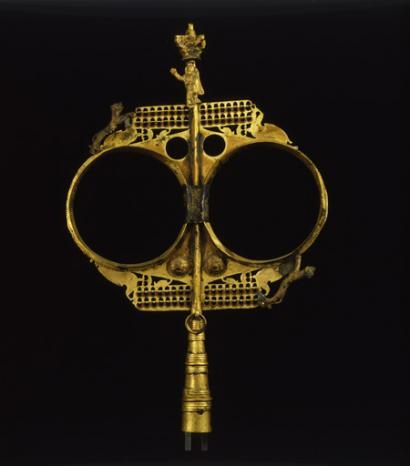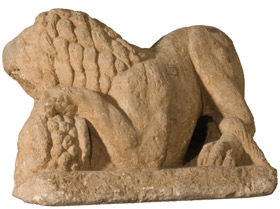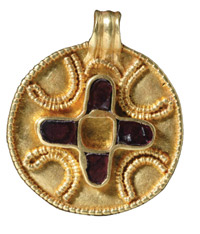- Bookmark / Share


- Delicious

- Scoopeo


- Technorati

- Digg

- Version française
CINQUANTENAIRE MUSEUM
NEW MEROVINGIAN AND GALLO-ROMAN GALLERIES
SINCE 2 DECEMBER 2009
The Cinquantenaire Museum unveils the renovated rooms dedicated to the Merovingian and the Gallo-Roman cultures
Gallo-Roman rooms: crowning of a standard. Flobecq (province of Hainaut). Inv. B 5569. |
MUSÉE DU CINQUANTENAIREParc du Cinquantenaire 10
INFORMATION:Tel: +32 (0)2 741 72 11
ADMISSION HOURS:Tuesday - Friday, 9:30 am to 5 pm
ADMISSION PRICE:5€ / 4€ / 1.50€ (school groups)
CURATORSHIP:Claire Massart: Curator of the Gallo-Roman collection
PRESS CONTACTS:Bart Suys
|
|
Following the conquest by Julius Cesar, between 57 and 51 B.C., Gaulle was integrated into the Roman Empire. The collections group together imported objects and local productions, brought in from various sites, and illustrate this new «Gallo- Roman» mixed culture. The tumulus built by the elites have protected these exceptional funerary installations and allowed archaeologists to find sigillated ceramic sets of tableware, glasses and decorated bronze recipients, jewels, symbolic figurines and refined personal objects, made in noble materials. The Romans imposed their official cults but they also gave free rein to ancestral devotions and to the introduction of religions from the Orient and consequently statuettes from the Roman pantheon are found together with native divinities. The exceptional standard of Flobecq is decorated with the image of the god Serapis. Areas are equally reserved to stamp collections, to military equipment, to various aspects of daily life and to re-enactments through life-size creations, in particular the one of the room in a home equipped with heating through hypocaust. A movie traces the history of the battles between Germanic populations and the Roman Empire and the progressive settlement of the new arrivals.
The Merovingian period that followed – between the Vth and the middle of the VIIIth centuries – corresponds to a new beginning in our regions. Tournai was the capital of Childeric’s kingdom, the first remarkable sovereign of that period, and remained an important political, cultural and religious centre. The material remnants come mainly from tombs. In spite of the progressive spreading of Christianity, the pagan custom of burying the dead with funeral offerings lasted for a long time: jewels and clothing accessories in gold inlaid with garnets and paste jewellery, as well as swords, shields, ceramics and textiles. Eight tombs from the necropolis of Harmignies have been rebuilt. Life-size, hyperrealist models participate in a funerary ritual: in a wooden sarcophagus, a young deceased woman, surrounded by a few close relatives, is being carefully prepared for her imminent funeral. The models’ clothing, shoes and accessories are replicas of real, Merovingian objects.
The deposit of material from the cemetery of Grez-Doiceau, the property of the Walloon region, enriches this collection. Very specific care has been given in the recently renovated rooms to the fact of replacing objects in their archaeological context through photos, drawings, models, re-enactments and casts. From this point of view, the faithful cast of the exceptional sarcophagus of Chrodoara - the original is kept at Amay - is particularly interesting. The accent was equally put on the know-how of the Merovingian artists. We must also note the special collaboration of artist Grzegorz Rosinski, the creator of Thorgal, to this event, with his large panoramic drawings in which the objects could be placed in their geographic setting.
|
||



